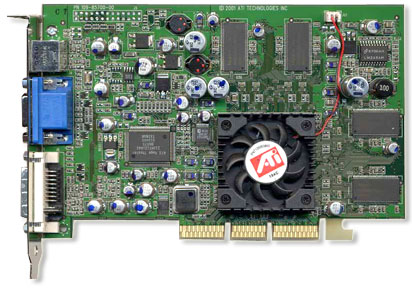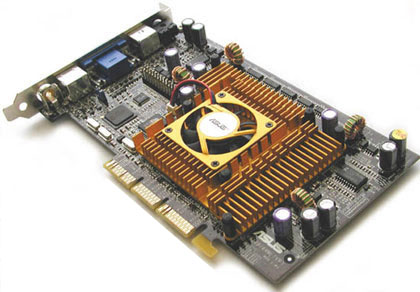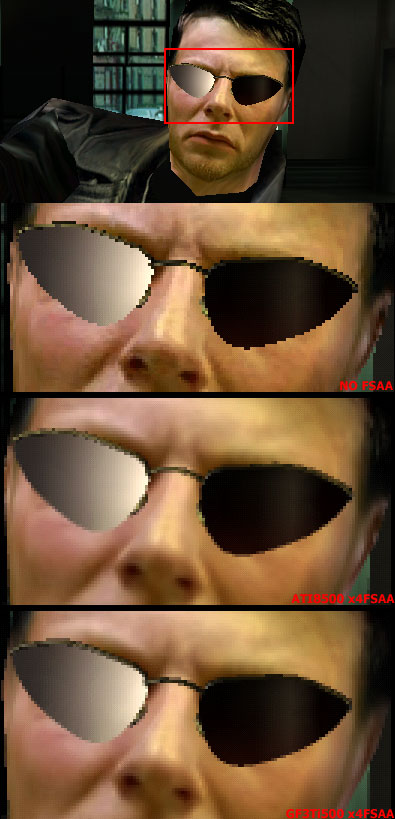
Just by looking at the heading, you my think that this is just a comparison review of only ATI8500LE and NVIDIA GeForce3 Ti500. In fact this review is also including the performance comparison of the four highest performance (and of course the highest price) graphic cards. These four cards are ATI8500LE(250/250MHz), GeForce3 Ti500(240/250MHz), GeForce3 Ti200(175/200MHz) and a standard GeForce3(200/230MHz).
The main idea of the review is to compare R200(ATI8500’s graphics processor) and NV20 (GF3 graphics processor). Thus we will generally concentrate on them but by the way we will also take a look at the performance results of Ti200 and Ti500.
R200, is the latest graphic chip of ATI that gives full hardware support to DirectX v8.x and ATI8500LE uses this chip as GPU. In fact there is no such a model on the market called 8500LE, it is only produced and sold to OEM companies. The only difference between ATI8500 is that the core and RAM frequencies are 250/250 MHz. instead of 275/275 MHz. R200, with its T&L (Transform, Clipping and Lighting) unit, called Charisma Engine II, has the ability to draw 69M polygons per second. Can reach up to a 8.8 GB/s bandwidth using 275 MHz. DDR Rams and its HyperZ-II technology. Its 3D rendering engine is called Pixel Tapestry-II and can process 6 textures at a time using 4 parallel rendering pipelines. This gives a fill-rate of 2.2 GigaTexel/s. Besides there is an FSAA engine called Smoothvision. Moreover, unlike NV20, it has dual-display support and gives a better 2D image quality with its 400MHz. RAMDAC. And finally ATI will announce R300 in the near future to compete with NVIDIA’s GeForce4.

NV20 is the latest graphics chip of NVIDIA that supports DirectX v8.x. The core is 200 MHz. and RAMs work at 230 MHz. But the Ti500 that we used in the review is at 240 MHz core and uses 250 MHz. DDR-RAMs just like ATI i8500LE. As you know, Ti500 and Ti200 both use NV20, the only difference is that they work at different core and Ram frequencies. NV20 uses a new generation T&L engine and it can draw 35M polygons per second. It offers a bandwidth of 8GB/s with the LightSpeed memory architecture. It has four rendering pipelines which all have 2 texture units. Can make FSAA at high resolutions using an algorithm called Quincunx and just like R200, has a programmable Pixel/Vertex Shader. The next versions which will be used in GeForce4s will have the NV25 and NV17 project names.

| R200(ATI8500LE) | NV20(Ti500) | |
| Core (Number of Transistors) | 60M | 57M |
| Manufacturing Process | 0.15 | 0.15 |
| Rendering Pipelines | 4 | 4 |
| Texture Units per Pipeline | 2 | 2 |
| Core Clock Speed (MHz) | 250 | 240 |
| DDR Memory Clock Speed (MHz) | 250 | 250 |
| Memory Bus | 128/bit DDR | 2 x 64-bit DDR |
| Memory Bandwidth (GB/s) | 8.8 | 8 |
| Hardware T&L Supported | Evet | Evet |
| Pixel & Vertex Shaders | Evet | Evet |
| DualDisplay | Evet | Hayır |
| RAMDAC | 400MHz | 350Mhz |
| Special Features | HyperZII, SmoothVision | LightSpeed Memory Architecture, HRAA |
While R200 supports Vertex Shader v1.1 and Pixel Shader v1.4, NV20 can only give support to v1.1 of Pixel Shader. And this difference leads to the results listed in the table below. While R200 can process six textures at a time, NV20 seems to process only four. Despite the fact that they both have 4 pipelines and 2 texture units per pipeline, ATI is better in this aspect. I think the Pixel Shader’s versions makes this difference. In the same manner there is a difference between the “Clipping Planes” and “Vertex Blend Matrices” performances. However, at the maximum texture size, NV20 gives support to 4 times bigger textures.
| ATI8500 | GF3Ti500 | |
| Max Texture Width : | 2048 | 4096 |
| Max Texture Height: | 2048 | 4096 |
| Max User Clipping Planes: | 6 | 0 |
| Max Active Hardware Lights: | 8 | 8 |
| Max Texture Blending Stages: | 8 | 8 |
| Textures In Single Pass: | 6 | 4 |
| Vertex Shader Version: | 1.1 | 1.1 |
| Pixel Shader Version: | 1.4 | 1.1 |
| Max Vertex Blend Matrices: | 57 | 0 |
| Max Texture Coordinates: | 6 | 8 |
After this introduction to the specs, let’s now take a look at their performances at 3D games and popular benchmarks. We have used the below configuration as the test set-up. All tests are made at 32Bit color and 85 Mhz. refresh rate (VerticalSYNC off). We have used the latest official DetonatorXP v23.11 drivers for NVIDIA GPUs and v6.13.10.6011 (currently beta) drivers for ATI. We have WinXP Pro as the OS and the 8.1 version of DirectX which comes as a standard with the OS.
| Test Setup | |
| CPU | Athlon XP1800 |
| Memory | 2 x 256MB PC2100 DDRRAM |
| Motherboard | MSI K7T266 Pro2 |
| Video Card | Asus V8200T5 64MB (240/250MHz,BIOS 3.20.00.18) Asus V8200T2 64MB (175/200MHz,BIOS 3.20.00.18) ABIT Suliro GF3 64MB (200/230MHz) ATI8500LE 64MB (250/250MHz,BIOS 1.0009) |
| Hard Drive | Seagate 330620 |
| Miscellaneous | Toshiba 32x CDROM, ElanVital 300W PSU 3Com 3C905B-TX ethernet |
| Software | Windows XP build 2600 NVIDIA DetonatorXP v23.11 ATI 6.13.10.6011 Direct X 8.1 build 820 |
First of all, let’s take a look at their performance at 3DMark 2000 v1.1 and 3DMark 2001 using both DX7 and DX8. For DX7 performance we have used 3DMark 200 and as seen below Ti500 is about 11% faster than ATI8500LE. However, ATI proves to be a little bit faster at 3DMark 2001, which uses DX8.

If we look at the detailed results of 3DMark2001, you see that ATI is a little bit faster in general. But when you consider the “High Polygon Count” tests, it is about 2 two times better in performance than Ti500. In fact it exceeds this rate at the polygon test with 8 lights.. Also at the “PointSprite” test, which processes 500K points on the stage, ATI again takes the lead. Using these results, we can conclude that ATI2s new Charisma Engine II is better than NVIDIA’s second generation T&L. Although at 3D game performance they give similar results, when you compare the “Vertex Shader” speed, ATI is far better, And if you consider the Pixel/Vertex Shader version supports we can say that R200 is better and faster than NV20 at DX8.

We had to use the v1.17 of Quake III arena because it is impossible to make “NV15Demo” of NVIDIA work with the other version. In fact there is not too much difference between v1.17 and v1.30 that can dramatically affect the performance. We have used two different resolutions and demos at the tests and the results were very close. Ti500 is 5% and 13% faster at 1024×768 and 1600×1200 respectively. Anyway, all these 4 cards are too fast to play Quake III Arena 🙂

We also wanted to check the FSAA performances at 1024×768 screen resolution in Quake 3 and the results can be seen in the table below. The x3 FSAA seen in the table represents the Quincunx mode in GeForces. Which is 3x FSAA at ATI. Although ATI in addition supports 5x and 6x FSAA, we decided not to include them in the tests though GeForce doesn’t have such modes to compare. ATI’s SmoothVision technology which is used for FSAA seems superior but we can’t say the same for the speed. GeForce3 Ti500 can perform 25% faster than ATI8500LE at 2x FSAA. And at 4x FSAA, Ti400 is about 70% better.

Although Smooth vision seems to have an improved and better FSAA quality, the facts are not so in reality. You can not feel the difference in motion, so we took the screen shots at 1024x768x32. In my opinion GeForce3 has a better 4x anti-aliasing performance when you consider the pixel’s colors and locations. And besides image quality, it is 75% faster at 4x FSAA. (I think that 2x anti-aliasing is quite enough while you play games. Indeed you don’t need to open AA if you can run your game at a resolution of 1600×1200)


